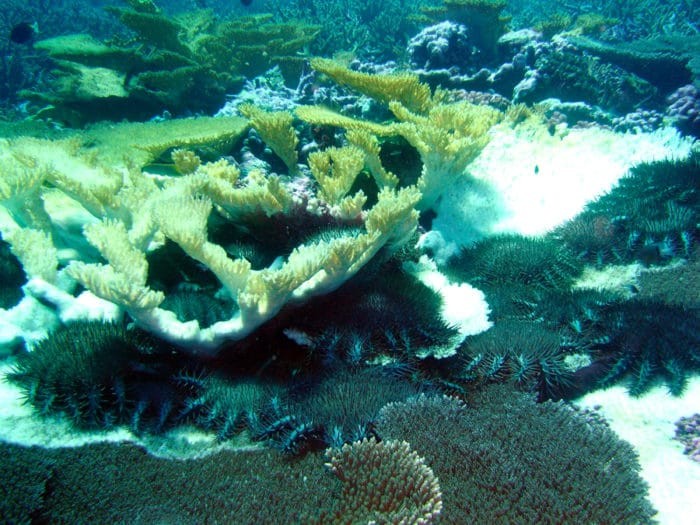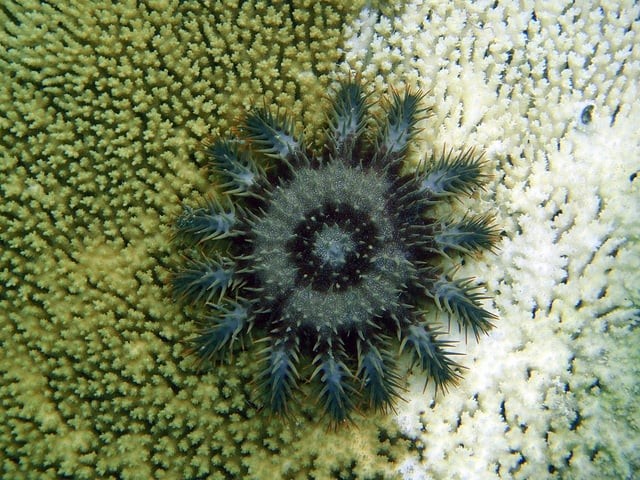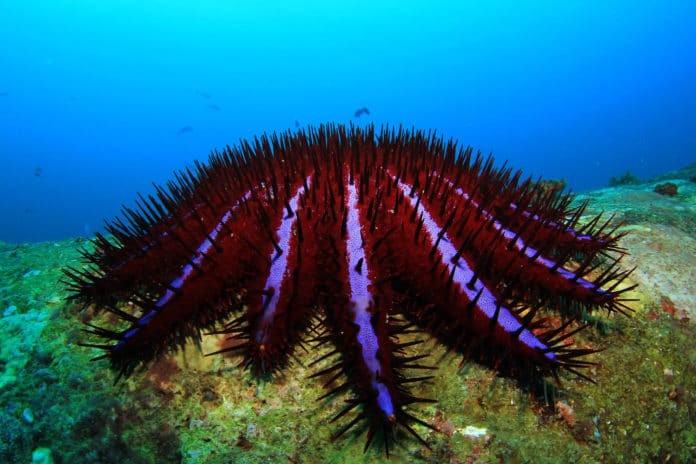We often hear of situations on a reef where the marine life gets out of balanced. Recently many the conversations deal with invasive species that wreck a local habitat. Zebra mussels have created a great deal of harm across Europe and North America. In the Gulf of Mexico and the Caribbean, the lionfish introduced from the Indo-Pacific have killed off a large percentage of the local marine life. In the Indo-Pacific, a local not an invader is causing all sort of problems. Crown-of-thorns starfish (COTS) are found throughout the Indo-Pacific region, occurring from the Red Sea and the coast of East Africa, across the Pacific and Indian Oceans, to the west coast of Central America. They help keep the reefs healthy as they eat some of the faster-growing corals and allowing the slower ones to get a foothold for growth. However, if the number of COTS gets too large, they can eat faster than the reef can recover.
Crown of Thorns Outbreaks
While most people use the name star fish, scientists are trying to get people to call them sea stars since they are not fish. Whether you use starfish or sea star, one thing clear is that the crown of thorns sea star is different. Most sea stars have five arms while the crown of thorns starfish has between 7 and 23 arms that radiate from a large central flatten disk. Sea stars are echinoderms meaning they have a spiny skin. The skin is hard and calcified, which helps protect them from predators. The COTS is covered in a softer, membranous skin, which is covered in hinged, elongate spines. These spines are venous to most marine species and to man as well. The body of the crown of thorns appears to be stiff, however, it is very flexible. It will crawl over the coral and wrap around it to eat. An adult COTS may grow to be a meter across, however, about half that size is more common. Crown of thorn starfish is able to move 20 meters a day, eating as they go.

On a healthy balanced reef there may be one or two crown of thorns per each hectare. The rate that they eat is balanced by how fast the reef can grow back. They generally eat the faster growing corals which helps the slower growing ones get established. In the process the diversity on the reef is improved. Scientist consider an outbreak exists when the number of COTS are such that they are eating more than can grow back or when the number of sea stars exceeds 30 per hectare. When the competition for the corals become too great, they will start eating the slow growing corals as well. A crown of thorns outbreak can destroy 6 square kilometers of healthy reef in a year, leaving nothing behind. In the 1970s, on the Great Barrier Reef, an eight year long COTS outbreak happened. At its peaked, some reefs had over 1000 starfish per hectare. In a few locations they were estimated at over 150,000 in a square kilometer. By the time a natural balance returned, 150 reefs were destroyed with no coral life left, another 500 reefs were heavily damaged.

In the last 30 years, the density of corals on the Great Barrier Reef has declined by an estimated 50%. there have been many reasons but forth as to the cause. Storms and man made disasters have taken their toll, as has pollution generated by man. However, it is though that half of the destruction has been caused by COTS. The great Barrier reef is the location most often mentioned when discussing this problem. However, it is happening in many parts of the Pacific. Reefs in Japan, Philippine and Indonesia are also suffering from outbreaks.
What Can Be Done
Scientists believe that these outbreaks have been going on for a million years, it the nature of nature. It was not until the 1950s, that man has become aware of them. Since the 1970s, the frequency, scope, and duration have been greatly increased. What causes the outbreaks is often debated among the experts. Each blaming their favorite target. One common agreement is that the outbreaks correspond with algae blooms.
Between December and April, the COTS will spawn, and it has been observed that during outbreaks they will spawn at the same time much like coral. During this breeding season, a female will release eggs a number of times and will release as many as 60 million eggs. The resulting larvae will float in the currents for two to four weeks before settling on a shallow reef. This means that an outbreak in one area can populate a distant reef far away.
After they settle, they transform to juvenile starfish which eat the algae on the corals. After about six months, they change their diet and start eating the coral itself. At this young age, the COTS has not grown their venomous spines and are prey for crabs, shrimp, and small fish. Once they do grow them there are only a few predators that they have to worry about. The humphead wrasse and the triton snail are two of the primary predators and their numbers are decreasing.
The most common method to clean a reef of Crown of Thorns is for scuba divers to go down, spear them and remove them from the reef. Chopping them up does no good, as they can regrow their bodies. This takes a bit of time and the divers risk getting in contact with the spines. Another method is to inject each starfish with a poison. However, it generally requires a number of injections in different parts of the animal. A couple of different poisons have been tried with good results including bile salts. Recently it was discovered that vinegar is effective and has no impact on the reef or any fish that may eat a poisoned COTS. It has now been added to the list of approved methods. There has even been a drone developed to search a reef for starfish and capture them.
The latest method being suggested is mimicking the COTS communications. Professor Bernie Degnan, from the University of Queensland’s School of Biological Sciences, said they have found that COTS can “smell” a chemical released during spawning and move towards it. There plan is to artificially create that chemical to lure COTS into traps.
Fred Nucifora, Great Barrier Reef Marine Park Authority Director of Tourism and Stewardship, said the organisation is targeting those reefs identified as having high conservation and tourism values. “Culling crown-of-thorns starfish is a critical management activity to protect coral cover and boost Reef resilience, particularly in the wake of coral bleaching,” he said.
Right now, the best way is still the culling by divers.

